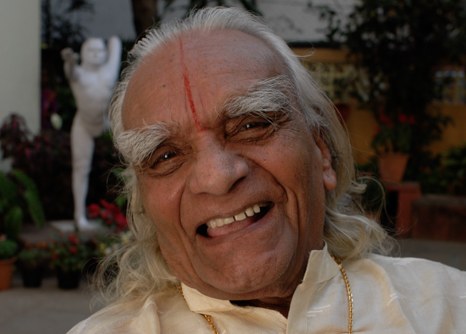Cambridge, MA. As many of you will know by now, BKS Iyengar, the distinguished and venerable master of yoga, died on August 20 at age 95. A student of the renowned T. Krishnamachari (1888-1989), who renewed yoga traditions for the modern era, Mr. Iyengar himself became a globally known and revered teacher himself. His disciples are found all over the world; many would come from afar for regular visits to his yoga center in Pune, India. His focus, I think, was on yoga for health, with an emphasis on physical practice such as would be available to people of all ages and conditions, even those who needed physical props to aid them in holding positions. When I visited his center in Pune in February, there was under way a special workshop for those seriously ill; many of those I saw seemed to be suffering from cancer and other debilitating diseases. He did not neglect the value of study, and seemed even in his old age increasingly intent on learning the wisdom of Patanjali’s Yoga Sutras, often taken to be the first and classic text of the traditions of yoga. Mr. Iyengar was a writer, and his books, such as Light on Yoga and Light on the Yoga Sutras have sold very widely, ever helpful to his students around the world.
But all of the preceding you can read in the obituaries for him, of which there are already many. And his disciples, some who have studied with him for four or five decades or more, will speak far more eloquently to his impact on their lives. All I can add are two things. First, readers of this blog will know that there is always controversy in some Christian communities about yoga, whether it is good and salutary for Christians, a complement and support for Christian faith, or rather a distraction or a subtle temptation that draws people away from the Christian faith entirely. Indeed, though even among experts this is debated, it can be taken to be a religion unto itself, a powerful reappropriation of body and thus too mind and soul, for an integral awareness that needs no other refuge. Certainly, I know a good number of people for whom yoga, often enough in the tradition of Mr. Iyengar, offers a spiritual way they had not found in the religion of their youth: Catholics practicing yoga; Catholic yoga; Yoga.
But this brief remembrance at the time of his death is not the place to repeat lengthy consideration of what yoga is, or how Christians should respond to the possibilities. I think rather more directly of the Gospel text that I would use, were there to be a Catholic memorial service for this master:
John said to him, ‘Teacher, we saw someone* casting out demons in your name, and we tried to stop him, because he was not following us.’ But Jesus said, ‘Do not stop him; for no one who does a deed of power in my name will be able soon afterwards to speak evil of me. Whoever is not against us is for us. (Mark 9: 38-40)
Now of course, Mr. Iyengar did not teach yoga in the name of Jesus; we need not exaggerate here. But neither need we resent a teacher who so clearly helped his disciples beyond their crippling disabilities of mind and body, who by attention to the inner secrets of the body cast out demons of the heart and intellectual. He opened a path of well-being and healing for so many, including followers of Christ. He was not against us; he was therefore, Jesus seems to be saying, for us. We who are Christian can see his “deeds of power,” in a deep sense, as “for Christ” and not “against Christ.” (He told me, the time we talked last February, that when he met John Paul II in Rome, the Pope told him that he would have loved to have Mr. Iyengar as his regular yoga teacher. But it was not to be.)
My second contribution is simply to draw your attention to his last book, Core of the Yoga Sutras (Harper Thorsons, 2012) This late in life writing brings together in a simple way much of his decades and life’s work in teaching. To my newcomer’s eyes, it seems to be one of the simplest and most unencumbered of his writings, wherein he sought out “the hidden links” inside the Sutras, in order to “unveil the core meaning, or heart,” of Patanjali’s wisdom on yoga. So I give Mr. Iyengar the last word, by quoting from page xxxv of his prologue. His words are grounded in his spiritual autobiography, the journey of his soul, and they radiate his discernment, his own spiritual exercises:
“I began practicing with reverence, to study my own body and mind in those rare moments when they were co-operating; usually there was a tug-of-war between them. Despite many restless and negative thoughts, I persisted and pursued my sadhana, and this began to transform my physical and mental framework, bringing positive thoughts and hopes. I began to observe the deep reflexes of my practices, and penetrate my inner self, which enthused me and brought me further understanding.
“My practice roused my instinctive reflex actions, which remain sharp even now in spite of my advanced age. They are innate responses to natural tendencies. I began correlating and transforming these natural tendencies that occurred in my sadhana with my own reflexive, intuitive thoughts, to achieve right and ever-lasting experiential feelings.”
And on page xxxvii,
“Each day, the moment I begin my sadhana, my entire being is transformed into a fresh state of mind. My mind extends and expands to the vastness. It is in that inner limitless space that I begin to work, trying various ways and means.”
May he now rest in the way he found, dwelling in the light, in the vastness of the ever-lasting bliss.







